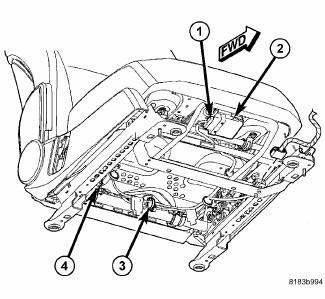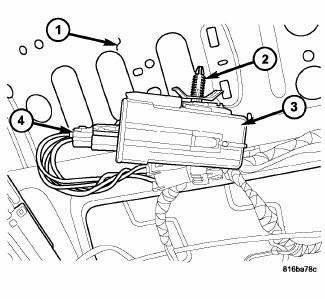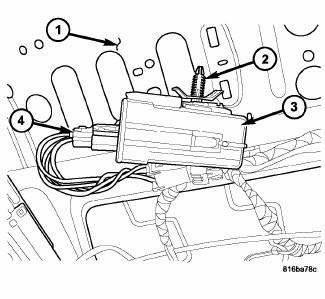Dodge Journey: Module, heated seat
DESCRIPTION

Fig. 35: Locating Heated Seat Module
The heated seat module (2) is located under the driver front seat. It has a single electrical connector (1) and a push pin style retainer that secures it to the seat pan (4). The module can be accessed from under the Driver seat with the seat in the full back and up position.
The heated seat module is a microprocessor designed to use the Local Interface Network (LIN) data bus messages from the instrument cluster, sometimes referred to as the Cab Compartment Node (CCN). The CCN receives inputs from the heated seat switches and in turn signals the heated seat module to operate the heated seat elements for both front seats.
OPERATION
The heated seat module operates on fused battery current received from the ignition switch. The module is grounded to the body at all times through the electrical connector. Inputs to the module include Local Interface Network (LIN) data bus messages and standard hardwired 12 volt power and ground. In response to the LIN inputs the heated seat module will control the battery current to the appropriate heated seat elements.
When a heated seat switch LIN data bus signal is received by the heated seat module, the module energizes the selected heated seat element. The Low heat set point is about 38º C (100.4º F), and the High heat set point is about 42º C (107.6º F).
In addition to operating the heated seat elements, the heated seat module sends LED illumination messages to the instrument cluster, sometimes referred to as the Cab Compartment Node (CCN) via the LIN data bus. The CCN then sends the LED illumination message to the accessory switch bank so that the appropriate LEDs are illuminated for any given heating level. Pressing the switch once will select high-level heating. Pressing the switch a second time will select low-level heating. Pressing the switch a third time will shut the heating elements off.
If the heated seat module detects a heated seat element OPEN or SHORT circuit, it will record and store the appropriate Diagnostic Trouble Code (DTC).
DIAGNOSIS AND TESTING
HEATED SEAT MODULE
In order to obtain conclusive testing, the heated seat system and the Local Interface Network (LIN) data bus circuit must be checked. Any diagnosis of the heated seat system should begin with, the use of a scan tool and the appropriate diagnostic service information.
Refer to SYSTEM WIRING DIAGRAMS for complete circuit schematic or connector pin-out information.
NOTE: Vehicles equipped with the heated seat option utilize a low voltage cut-off feature. This feature turns off power to the heated seat system anytime vehicle voltage is below 11.7v or above 15.5v. Be certain to check the vehicle electrical system for proper voltage anytime the power seat system appears inoperative.
Before any testing of the heated seat system is attempted, the battery should be fully-charged.
REMOVAL

Fig. 36: Locating Heated Seat Module
CAUTION: The Heated Seat Module mounting tab can be damaged during module removal and installation. Use care to properly align tab to prevent binding that could result in tab breakage.
1. Position the driver front seat to the full rearward position.
2. Disconnect and isolate the battery negative cable.
3. Disconnect the wire harness connector (4) from the heated seat module (3).
4. Unsnap the heated seat module retaining tab (2) from the seat pan (1).
5. Remove the heated seat module (3) from the vehicle.
INSTALLATION

Fig. 37: Locating Heated Seat Module
CAUTION: The Heated Seat Module mounting tab can be damaged during module removal and installation. Use care to properly align tab to prevent binding that could result in tab breakage.
1. Install the heated seat module (3) into the vehicle.
2. Position the retaining tab (2) with the mounting hole in the seat pan (1). Firmly apply even pressure to the module (3) until the mounting tab is fully seated.
3. Connect the wire harness connector (4) to the heated seat module (3).
4. Connect the battery negative cable.
5. Check for proper heated seat system operation.
 Module, final drive control
Module, final drive control
DESCRIPTION
The AWD ECM (electronic control module) mounts on the driver side cowl side
panel, where it is concealed by
the instrument panel. It communicates with other systems over the high-speed ...
See also:
Removal
WARNING: Refer to the applicable warnings and cautions for this
system before
performing the following operation. Failure to follow these instructions
may
result in serious or fat ...
Standard procedure
ENGINE GASKET SURFACE PREPARATION
Fig. 4: PROPER TOOL USAGE FOR SURFACE PREPARATION
To ensure engine gasket sealing, proper surface preparation must be
performed, especially with the use of
alu ...
Uconnect™ Multimedia (SIRIUS BACKSEAT TV™) — IF EQUIPPED
Satellite video uses direct satellite receiver broadcasting
technology to provide streaming video. The subscription
service provider is SIRIUS Satellite Radio. SIRIUS Backseat
TV™ offers three vi ...

